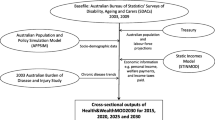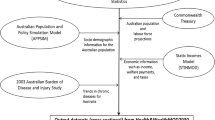Abstract
Few studies have assessed the impact of co-morbid conditions amongst patients with arthritis. This study will quantify the impact co-morbid health conditions have on the labour force status and economic circumstances of people with arthritis. This study uses a microsimulation model, Health&WealthMOD, to quantify the impact of co-morbidities on the labour force participation and economic circumstances of 45- to 64-year-old Australians with arthritis. The results show that the probability of being out of the labour force increases with increasing number of co-morbidities. However, there was no statistically significant difference in the amount of weekly private income received by people with arthritis and no co-morbidities, and people with arthritis and one or two co-morbidities. However, those with arthritis and three or more co-morbidities received a weekly private income 72 % lower than people with arthritis alone (95 % CI −82, −57). People with arthritis and co-morbidities paid less in tax and received more in government transfer payments. As such, it is important to consider the co-morbid conditions an individual has when assessing the impact of arthritis on labour force participation and economic circumstances. People with arthritis that have multiple co-morbid conditions are likely to have their labour force participation and economic circumstances interrupted much more than those with arthritis only.
Similar content being viewed by others
References
Song J, Chang R, Dunlop D (2006) Population impact of arthritis on disability in older adults. Arthritis Care Res 55(2):248–255
Dunlop D, Manheim L, Sohn M, Liu X, Chang R (2002) Incidence of functional limitation in older adults: the impact of gender, race, and chronic conditions. Arch Phys Med Rehabil 83:964–971
Boult C, Kane R, Louis T, Boult L, McCaffrey D (1994) Chronic conditions that lead to functional limitation in the elderly. J Gerontol 49:M28–M36
Australian Institute of Health and Welfare (2008) Australia’s health 2008. AIHW, Canberra
Gignac M, Cao X, Lacaille D, Anis A, Badley EM (2008) Arthritis-related work transitions: a prospective analysis of reported productivity losses, work changes, and leaving the labor force. Arthritis Care Res 59(12):1805–1813
Verstappen SMM, Boonen A, Bijlsma JWJ, Buskens E, Verkleij H, Schenk Y, van Albada-Kuipers GA, Hofman DM, Jacobson JWG (2004) Working status among Dutch patients with rheumatoid arthritis: work disability and working conditions. Rheumatology 44(2):202–206
Burton W, Morrison A, Maclean R, Ruderman E (2006) Systematic review of studies of productivity loss due to rheumatoid arthritis. Occup Med 56(1):18–27
Schofield D, Shrestha R, Passey M, Earnest A, Fletcher S (2008) Chronic disease and labour force participation among older Australians. Med J Aust 189:447–450
Fortin M, Hudon C, Bayliss EA, van der Akker M (2007) Multimorbidities many challenges: time to focus on the needs of this vulnerable and growing population. Br Med J 334:1016–1017
Gabriel SE, Crowson CS, O’Fallon WM (1999) Comorbidity in arthritis. J Rheumatol 26(11):2475–2479
Mikus TR, Saag KG (2001) Comorbidity in rheumatoid arthritis. Rheum Dis Clin N Am 27(2):729–752
Lee S, Tsang A (2007) Huang YQ, Zhang MY, Liu ZR, He YL, Von Korff M, and K. RC, Arthritis and physical-mental comorbidity in metropolitan China. J Psychosom Res 63(1):1–7
Verbrugge LM, Gates DM, Ike RW (1991) Rick factors for disability amongst US adults with arthritis. J Clin Epidemiol 44(2):167–182
Stang PE, Brandenburg NA, Lane MC, Merikangas KR, Von Korff MR, Kessler RC (2006) Mental and physical comorbid conditions and days in role among persons with arthritis. Psychosom Med 68(1):152–158
Organisation for Economic Co-operation and Development (2007) Labour force statistics 1986–2006. OECD, Paris
Centrelink (2009) Age pension–eligibility. Cited 2011 13/7 http://www.centrelink.gov.au/internet/internet.nsf/payments/age_eligible.htm
OECD (2011) Pensions at a glance 2011: retirement-income systems in OECD and G20 countries. OECD, Paris
Schofield DJ, Shrestha RN, Passey ME, Earnest A, Fletcher SL (2008) Chronic disease and labour force participation among older Australians. Med J Aust 189(8):447
Schofield D, Shrestha R, Percival R, Callander E, Kelly S, Passey M (2011) Early retirement and the financial assets of individuals with back problems. Eur Spine J 20(5):731–736
Schofield D, Percival R, Passey M, Shrestha R, Callander E, Kelly S (2010) The financial vulnerability of individuals with diabetes. Br J Diabetes Vasc Dis 10(6):300–304
Schofield D, Shrestha R, Callander E, Percival R, Kelly S, Passey M, Fletcher S (2011) Modelling the cost of ill health in Health&WealthMOD (Version II): lost labour force participation, income and taxation, and the impact of disease prevention. Int J Microsimulation 4(3):32–36
Schofield D, Kelly S, Shrestha R, Callander E, Passey M, Percival R (2010) Long term financial impacts of CVD: living standards in retirement. Int J Cardiol 155(3):406–408
Schofield D, Shrestha R, Percival R, Kelly S, Passey M, Callander EJ (2011) Quantifying the effect of early retirement on the wealth of individuals with depression or other mental illness. Br J Psychiatry 198:123–128
Schofield D, Passey M, Percival R, Shrestha R, Callander E, Kelly S (2010) Retiring early with cardiovascular disease—impact on individual’s financial assets. Int J Cardiol 146(1):125–126
Schofield D, Kelly S, Shrestha R, Callander E, Passey M, Percival R (2011) How depression and other mental illness can affect future living standards of those out of the labour force. Ageing Ment Health 15(5):654–662
Schofield D, Callander E, Shrestha R, Percival R, Kelly S, Passey M (2012) Labour force participation and the influence of having CVD on income poverty of older workers. Int J Cardiol 156(1):80–83
Australian Bureau of Statistics (2004) Survey of disability, ageing and carers, 2003. ABS, Canberra
Lambert S, Percival R, Schofield D, Paul S (1994) An introduction to STINMOD: a static microsimulation model. NATSEM, Canberra
Percival R, Abello A, Vu QN (2007) STINMOD (Static Income Model) 2007. In: Gupta A, Harding A (eds) Modelling our future: population ageing, health and aged care. Elsevier, Amsterdam, pp 477–482
Australian Bureau of Statistics (2003) Information paper–basic confidentialised unit record file: survey of disability, ageing and carers (reissue). ABS, Canberra
Rässler S (2002) Statistical matching: a frequentist theory, practical applications, and alternative Bayesian approaches. Springer, New York
Teece M (2013) Increasing equity, compacting quality. Group of Eight: http://www.go8.edu.au/__documents/newsletters/2013-/increasing-equity_compacting-quantity-by-mike-teece.pdf
Kadam UT, Jordan K, Croft PR (2004) Clinical comorbidity in patients with osteoarthritis: a case-control study of general practice consulters in England and Wales. Ann Rheum Dis 63:408–414
Kriegsman DMW, Deeg DJH, Stalman WAB (2004) Comorbidity of somatic chronic diseases and decline in physical functioning: the Longitudinal Aging Study Amsterdam. J Clin Epidemiol 57:55–65
Dunlop D, Lyons JS, Manheim L, Song J, Chang R (2004) Arthritis and heart disease as risk factors for major depression: the role of functional limitation. Med Care 42(6):502–511
Dickens C, Jackson J, Tomenson B, Hay E, Creed F (2003) Association of depression and rheumatoid arthritis. Psychosomatics 44:209–215
Rupp I, Boshuizen HC, Jacobi CE, Dinant HJ, van den Bos GAM (2004) Comorbidity in patients with rheumatoid arthritis: effect on health-related quality of life. J Rheumatol 31(1):58–65
DeMaria AN (2002) Relative risk of cardiovascular events in patients with rheumatoid arthritis. Am J Cardiol 89(6):S1
Acknowledgments
The development of the microsimulation model used in this research, Health&WealthMOD, is funded by the Australian Research Council (under Grant LP07749193), and Pfizer Australia is a partner to the grant.
Conflict of interest
The authors have no conflicts of interest to declare.
Author information
Authors and Affiliations
Corresponding author
Rights and permissions
About this article
Cite this article
Schofield, D.J., Callander, E.J., Shrestha, R.N. et al. How co-morbidities magnify the effect of arthritis on labour force participation and economic status: a costs of illness study in Australia. Rheumatol Int 34, 481–489 (2014). https://doi.org/10.1007/s00296-014-2967-5
Received:
Accepted:
Published:
Issue Date:
DOI: https://doi.org/10.1007/s00296-014-2967-5




